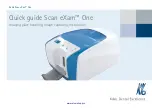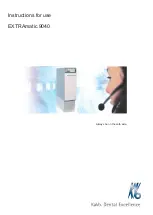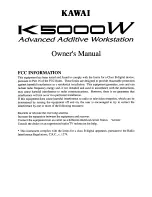
KRA Refrigeration System Installation, Operation & Maintenance Manual
L-3571 ENGLISH
9
S
IGHT
G
LASS
/M
OISTURE
I
NDICATOR
On the condensing units, there is a sight glass located directly inside the front cover. This glass will communicate many things
about the system’s operating condition.
1.
The glass should show foam upon start-up. This should clear after a few minutes of running. If it doesn’t clear, the
charge could be low. If there was no foam upon start-up, the system may contain no refrigerant. The glass does not
have to be full to operate correctly. The sight glass is not to be used for charging purposes, but may help indicate an
issue with the charge. Use proper procedures as shown in “Recharging The System” on page 12.
2.
There is a colored media around the hole inside the glass. When it is green, the system is dry. When it is yellow, the
system is wet. Wet systems are systems that contain moisture. This will not allow your system to work correctly. See
“TROUBLESHOOTING GUIDE” on page 14.
3.
Upon unboxing the condensing unit, the sight glass may be yellow. This generally occurs because the media needs a
liquid flow over it to correctly measure the moisture content. Hook up the unit, and let it run for about 30 minutes. The
sight glass should turn green.
T
HERMOSTAT
The thermostat controls the operation of the condensing unit based on box temperature. Set it to a point that conforms to the
box and system design. One thermostat is required for each box. Thermostats may be located on the condensing unit, or
remotely.
Each box thermostat should be set to the designed-condition temperature. For example, a 40°F/4.4°C drink box should be set to
40°F/4.4°C for operation. Setting this thermostat down to 15°F/-9.4°C will (A) not reach this temperature as the refrigeration
system is not designed for this load, and (B) forcing any refrigeration system well below design conditions will extend the
compressor’s run time significantly, resulting in shortened unit life. To set the thermostat, see “Thermostat Operation” on
page 10.
Thermostat bulb or thermistor should be mounted one-third of the way down
from the top
on the longest side wall in the box.
Mount it in a position where it can sense average box temperature. Do not mount bulb or thermistor near the box opening.
Replacement thermistor cover plates are available from your dealer.
R
EFRIGERANT
C
HARGE
•
All Systems -
The system is relatively charge insensitive due to the large receiver that allows the condensing unit to
be charged with enough refrigerant to handle most normal plate and line configuration. No further charging should be
required for most applications.
•
Linesets and Plates -
Typically, these have been evacuated and vapor charged.
•
Repair -
If the charge is lost, or is suspected to be incorrect, the system must be evacuated and recharged with the
proper amount of R-404A. See “Recharging The System” on page 12.
See Figure 10: Refrigerant Pressure-Temperature Chart, page 21.
REFRIGERATION SYSTEM OPERATION
This section of the manual refers to essential safe operation for all KRA refrigeration systems. For any operational problems call
your authorized dealer or the Dometic Marine Service Department at +1 954-973-2477.
KRA R
EFRIGERATION
S
TART
-U
P
C
HECK
L
IST
B
EFORE
Y
OU
S
TART
T
HE
S
YSTEM
1.
Check that all refrigerant connections are tightened to10-12 ft. lbs.
2.
Check to make sure that all refrigerant lines are secured so they do not rub against other objects during operation.
3.
Ensure all suction line connections and the TXV assembly are insulated to prevent ice build-up.
4.
Confirm that electrical connections are correct, and are tight.
5.
Make sure that thermostat is securely mounted, and wires are routed safely.
6.
Make sure that unit is securely mounted.
7.
If applicable, check to make sure that airflow into and out of the unit is not obstructed.
8.
Check water connections (if used) to make sure that they have correct flow direction, and that connections are tight
and have two clamps.










































